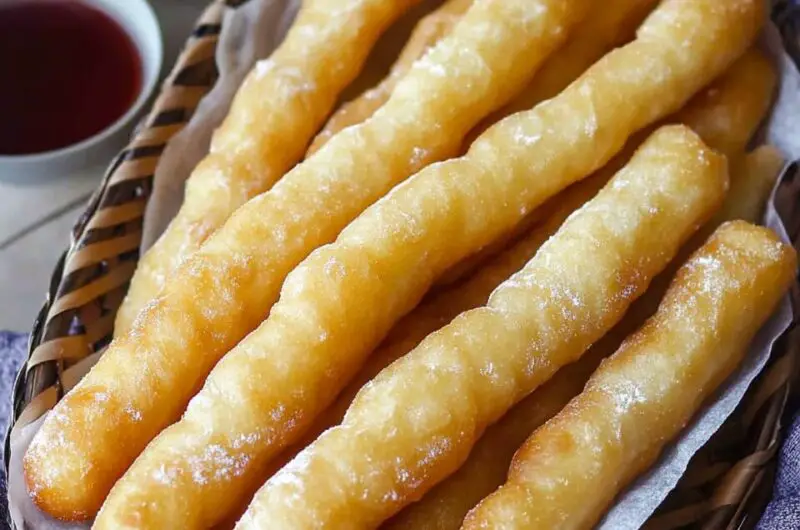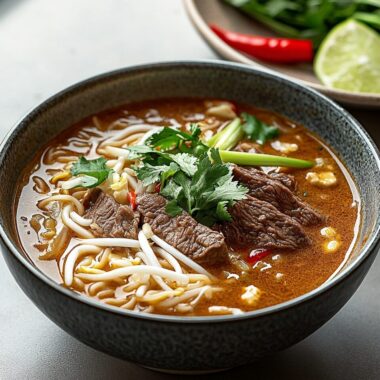The Chinese Doughnut Stick, or Youtiao, is a beloved breakfast item across China and many parts of Asia. These light and airy golden sticks are slightly salty, wonderfully crisp on the outside, and chewy inside ideal when dunked into a bowl of warm soy milk or served alongside savory congee. Making Youtiao at home may seem intimidating, but this recipe simplifies the process while preserving the authentic flavor and texture of traditional Chinese street food. Whether you’re reliving childhood memories or exploring new culinary traditions, this dish delivers pure comfort and joy with every crispy bite.
Full Recipe:
Ingredients:
-
2½ cups all-purpose flour
-
1 tsp aluminum-free baking powder
-
½ tsp baking soda
-
¾ tsp salt
-
1 large egg
-
¾ cup water
-
1 tbsp neutral oil (plus more for frying)
-
Extra flour for dusting
Directions:
-
In a large mixing bowl, sift together the flour, baking powder, baking soda, and salt.
-
In a separate bowl, beat the egg, then mix in the water and 1 tablespoon of oil.
-
Gradually add the wet ingredients to the dry, stirring until a shaggy dough forms.
-
Knead the dough until smooth, about 8–10 minutes. Cover and let it rest for 30 minutes.
-
Knead briefly again, then cover and let the dough rest for at least 1 hour (up to overnight in the fridge).
-
Roll out the dough on a floured surface into a rectangle about ½ inch thick. Cut into strips 1 inch wide and 4–5 inches long.
-
Stack two strips, one on top of the other. Use a chopstick to press a line down the center to seal them together.
-
Heat oil in a deep pot to 375°F (190°C).
-
Carefully stretch each dough pair slightly and gently lower into the hot oil.
-
Fry while turning constantly until golden and puffed, about 2–3 minutes per stick.
-
Remove and drain on paper towels. Serve warm with rice porridge, soy milk, or on their own.
Prep Time: 1 hour 15 minutes (including rest)
Cooking Time: 15 minutes
Total Time: 1 hour 30 minutes
Kcal: 135 kcal per stick
Servings: 8–10 sticks
A Cultural Breakfast Staple
Youtiao (油条), also known as Chinese doughnut sticks or Chinese crullers, are a quintessential part of traditional Chinese breakfast culture. Often enjoyed alongside warm soy milk or a steaming bowl of congee, these golden, airy sticks are cherished for their simplicity, satisfying texture, and nostalgic value. From bustling street vendors in Beijing to homemade renditions passed down through generations, Youtiao has stood the test of time as a morning favorite in Chinese households.
Unlike the sugary doughnuts commonly found in the West, Youtiao are savory and slightly salty. Their beauty lies in their minimalist design: a pair of dough strips, pressed together and deep-fried until they puff into golden-brown wands of deliciousness. While they are crispy on the outside, their interior remains soft and stretchy an irresistible contrast that makes them perfect for dipping or enjoying plain.
The Origin and Symbolism of Youtiao
The origins of Youtiao date back over a thousand years, rooted in both culinary ingenuity and political protest. One of the most popular folk stories traces Youtiao back to the Song Dynasty (960–1279), when a corrupt minister named Qin Hui orchestrated the wrongful death of a patriotic general, Yue Fei. In a symbolic act of rebellion, angry citizens created a fried dough representation of the minister and his wife two dough pieces pressed together and fried. This act of protest became a breakfast dish: a ritualistic “eating of the traitors.”
Though modern-day eaters may not think about the folklore behind their breakfast, this narrative adds a fascinating historical layer to what might otherwise be considered a simple snack. In this way, Youtiao is more than just food it’s an edible piece of history.
How Youtiao Fits into Chinese Culinary Culture
In Chinese cuisine, texture is just as important as flavor. Youtiao exemplifies this with its contrasting mouthfeel the thin, crispy shell gives way to a warm, airy interior. It is this balance that makes Youtiao so popular and adaptable.
Youtiao is often paired with rice porridge (congee) or soy milk. The stick can be dipped into the liquid to soak up flavor or eaten on its own for a satisfying crunch. In Southern China, it is sometimes wrapped in a rice noodle roll (cheung fun), forming a popular dim sum dish known as zhaliang. In Taiwan, Youtiao may be sandwiched inside a sesame flatbread or used to scoop up savory soybean curd (douhua).
The versatility of Youtiao also means it can easily be adapted into fusion dishes. In recent years, creative chefs have used them as sandwich buns, salad toppers, or even dessert bases, drizzled with sweet condensed milk.
The Science Behind the Puff: Fermentation and Frying
While the ingredient list for Youtiao is short and simple flour, baking powder, baking soda, salt, egg, and water mastering its texture is a science. The dough must be allowed to rest for a significant period (often overnight), allowing the leavening agents to work their magic. During frying, the moisture in the dough rapidly expands into steam, causing the sticks to puff up dramatically.
One hallmark of a good Youtiao is its symmetrical, hollow center with a delicate, honeycomb-like crumb. This is achieved through precise temperature control during frying and ensuring that the dough strips are properly pressed and stretched before hitting the hot oil.
The frying technique is crucial. Youtiao must be gently turned as they fry to ensure even browning and puffing. Too hot, and the outside burns before the inside cooks; too cold, and they absorb excess oil and become greasy. An ideal temperature hovers around 375°F (190°C).
Why Make Youtiao at Home?
While Youtiao is readily available in many Chinese bakeries and street stalls across Asia, making it at home offers several advantages. First and foremost, it ensures freshness Youtiao is best enjoyed minutes after it leaves the oil, while still crisp and warm. Secondly, homemade Youtiao allows you to control ingredients, making it suitable for those with dietary restrictions or preferences.
Many packaged Youtiao or restaurant versions use ammonium bicarbonate (an aggressive leavening agent with a strong odor). By contrast, this homemade recipe uses a blend of baking soda and baking powder for a gentler rise and a more pleasant taste.
Additionally, making Youtiao from scratch can be a rewarding culinary challenge. The process requires patience, attention to detail, and practice qualities that resonate with the essence of traditional Chinese cooking.
Regional Variations and Modern Twists
Across China and beyond, Youtiao has taken on many forms. In the north, it is typically served with savory soy milk, often seasoned with soy sauce, vinegar, and chili oil. In southern regions like Guangdong, it might accompany congee or be wrapped in noodle rolls.
In Southeast Asia, the influence of Chinese cuisine has introduced Youtiao-like variations such as cakwe in Indonesia, pathongko in Thailand, and youtiao in Vietnam. These regional takes might include subtle changes in shape, size, or added ingredients like sesame seeds.
Modern renditions of Youtiao also explore new territory. Some foodies have experimented with air-frying or baking the dough to reduce oil content. Others have infused the dough with herbs, spices, or even cheese to reinvent the traditional flavor. The adaptability of Youtiao makes it a canvas for culinary creativity, whether you stick to tradition or experiment with fusion.
Pairing Suggestions: How to Enjoy Youtiao
Youtiao is most commonly enjoyed with:
-
Soy milk (warm or chilled): Dip for a savory-salty contrast.
-
Congee: Tear the Youtiao into chunks and soak in the porridge.
-
Rice rolls (zhaliang): Wrap Youtiao in steamed rice noodles for texture contrast.
-
Sweetened condensed milk: Drizzle for a unique East-meets-West dessert.
-
Douhua (soybean pudding): A savory-sweet combo enjoyed in Taiwan and parts of Southern China.
You can even try it Western-style by serving it alongside soup, eggs, or salad. However you pair it, Youtiao’s versatility shines through.
Advertisement
Tips for Success When Making Youtiao
-
Let the dough rest: This step is non-negotiable. It develops gluten and allows leavening agents to activate.
-
Keep oil temperature consistent: Use a thermometer to maintain around 375°F.
-
Do not overcrowd the pan: Fry in batches to avoid temperature drops and uneven frying.
-
Use fresh oil: Old oil imparts bitterness and darkens too quickly.
-
Practice stretching: A gentle tug before frying helps achieve the signature puff.
With time and practice, your homemade Youtiao will rival any store-bought version and you’ll enjoy the pride of mastering a time-honored tradition.
Conclusion:
Chinese doughnut sticks, or Youtiao, offer a beautiful blend of tradition, texture, and cultural meaning. Their humble ingredients belie their rich history, intricate technique, and emotional significance in Chinese cuisine. More than just a breakfast item, Youtiao represents a connection to heritage, a culinary ritual, and a source of simple comfort.
Whether you grew up eating Youtiao on the streets of Guangzhou or you’re discovering them for the first time in your home kitchen, this iconic treat brings joy in every crispy, golden bite. By learning to make Youtiao at home, you not only nourish your body you also participate in the preservation and appreciation of one of China’s most beloved culinary traditions.








